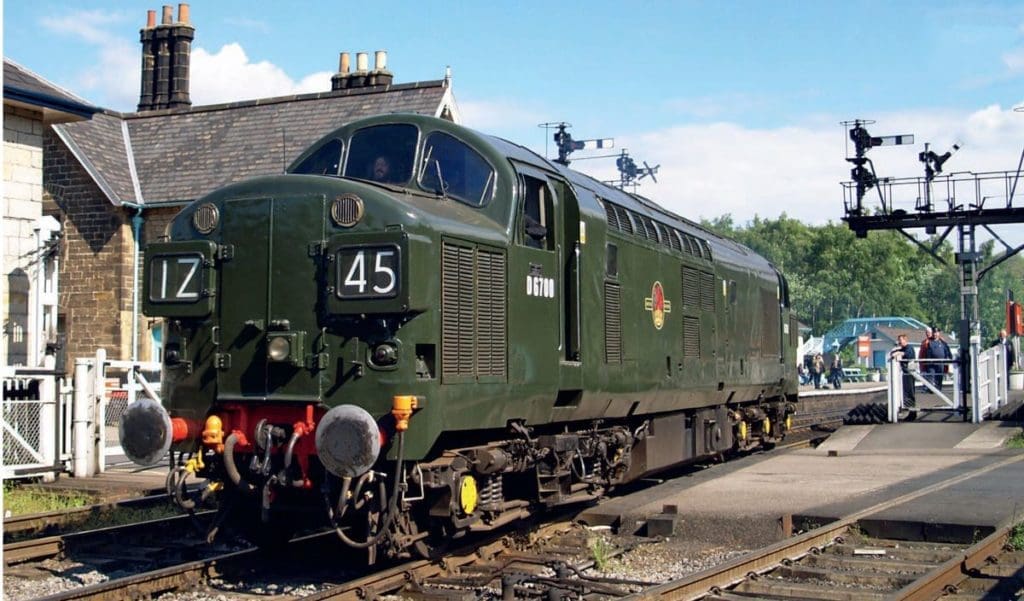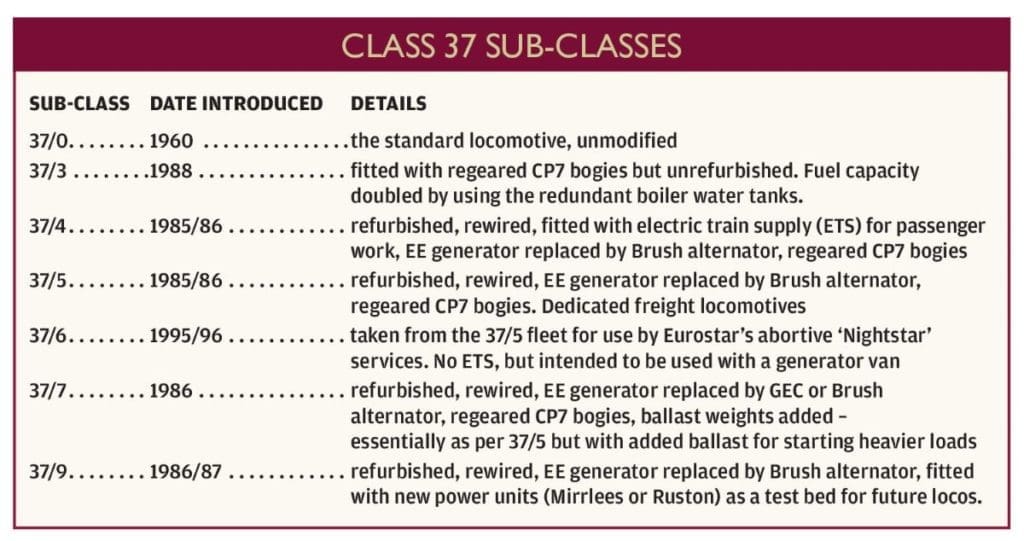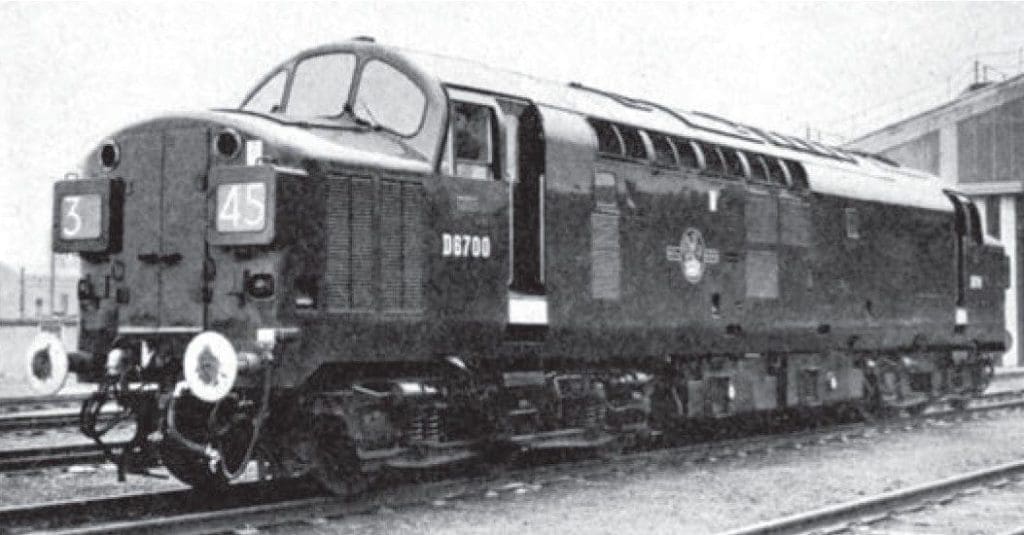From The Railway Magazine, December 2010, Paul Bickerdyke looks at the Class 37 Golden Jubilee.

In December, the pioneer Class 37 No. D6700 reaches its half-century. Paul Bickerdyke takes a look at some of the key moments in the history of the locomotive and the class generally


Class 37s are without doubt one of the most successful diesel locomotives born out of the British Railways Modernisation Plan of the 1950s.
Enjoy more Railway reading in the monthly magazine.
Click here to subscribe & save.
These medium-powered locos were intended for mixed-traffic use and over the last 50 years have more than lived up to that role, handling all types of freight and passenger duties in all parts of the network. And that gutsy, go-any-where, do-anything ability has made them firm favourites with operators and enthusiasts alike.
Perhaps a key to the success of the English Electric (EE) Type 3s, as they were first known, is that they were not a brand new design but drew on the experience of locomotives already in service. The EE 12CSVT engine was a de-rated (1,750hp) version of that used in a similar type of loco EE had built for use in East Africa. Internally, many of the components were based on those used in the company’s Type 4 (Class 40) then in production. And the Co-Co bogies were to become a company standard type, interchangeable with those used by the later Classes 55 and 50.
First off the production line at the Vulcan Foundry in Newton-le-Willows, Lancs, was No. D6700, which was released into traffic on December 2, 1960 in BR green livery with a light grey roof, red bufferbeams and black undergear. A further 308 examples were to be built in variously-sized batches over the next five years, the first 118 with nose-end gangway doors and split-headcode box (Phase 1 type) and the rest with sealed nose-end and central four-character headcode box (Phase 2).
The doyen of the class was allocated new to Stratford MPD, in east London, where it was put to work on freight and passenger turns on the former Great Eastern lines. Amongst other duties, the pioneer loco and its sisters some- times substituted for their larger Type 4 cousins on expresses between London and Norwich – schedules they could just about keep if given a clear run – and, in December 1960, D6700 was noted working trains between Liverpool Street, Norwich and Great Yarmouth.
Then, on January 6, 1961, it had its first passenger working on the Cambridge route when it was taken off a test train in the Stansted area to rescue the up ‘Fenman’, which had failed behind Brush Type 2 (Class 31) No. 5665. Three days later, D6700 had its first official working on the line, hauling the 5.56pm Liverpool Street-Cambridge and 9.20pm return – a working that heralded a 20-year-plus association with the class on that route.

By the summer of 1961, EE Type 3s had replaced ‘Britannia’ Pacifics on the Harwich- Liverpool Central boat train – first as far as Sheffield Victoria, then later through to Manchester Piccadilly, becoming the only daytime diesels diagrammed over the electrified Woodhead route. D6700 was noted on that working several times.
BR’s Eastern and North Eastern Regions were the first to receive EE Type 3s, but eventually they were to spread all over the country and, during the next 30 years, D6700’s allocations illustrated this with spells at Eastern Region depots such as Stratford and Thornaby; on the Scottish Region at Haymarket, on the Western at Cardiff Canton and on the London Midland at Toton.
An interesting period was a three-month allocation in January 1968 to Derby Research Centre, where it became a test-bed for push-pull equipment for possible use on Edinburgh-Glasgow shuttles. In the event, the scheme was abandoned in favour of using two BRCW Type 2s (Class 27s) in top-and-tail formation.
After the end of steam on BR in August 1968, D6700, in common with other diesels, had the ‘D’ prefix dropped from its identity. Then, from the late-1960s, BR began rolling out its new corporate image and No. 6700 duly received a new livery of standard BR blue with full yellow ends in June 1969.
TOPS renumbering, under which EE Type 3s became Class 37s, began in the early-1970s. They were largely renumbered in order; thus D6701-6999 became 37001-299 and the final nine locos in the fleet (which had carried the numbers D6600-6608) became 37300-308. However, D6700 presented a problem as 37.000 would not have been a computer-recognisable set of digits under TOPS. Tagging it on at the end as 37309 would also not have been ideal as it was a Phase 1 loco and would thus have been out of sequence.
The solution came as there was a gap in the numbers due to the fact that Phase 2 loco No. D6983 had been written off in a collision in December 1965. Thus D6819 (the first of the Phase 2 locos) became 37283 (rather than 37119), allowing D6700 to take the identity of 37119 in February 1974.
Towards the end of the 1970s and into the early-’80s there was a declining need for steam-heat on passenger work as more and more locos and coaches were fitted with electric train heating. So No. 37119 lost its boiler and the water tank was replaced by an additional fuel tank in October 1982.
In the mid-1980s BR considered replacing the Class 37s with a totally new build of locomotive, but eventually decided on the cheaper option of refurbishing them to extend their working life. For the first time, the common user fleet was to be split up into dedicated sub-classes for freight and passenger work (see table on previous page).
All would receive re-geared bogies, while Phase 1 examples lost their split headcode boxes in favour of simple marker lights and Phase 2 types had their central headcode boxes plated over.
Refurbishment

Initially, the whole fleet was planned to be refurbished, but the programme ended early after 135 locos had been treated. However this left a surplus of re-geared bogies, so it was decided to give another batch of locos a standard works overhaul, fit them with these modified bogies, and create a new 37/3 sub-group.
In the late-1980s, BR was split up into dedicated business groups, with most 37s becoming part of Railfreight. This group was then further broken down into sectors for specific traffic flows and, in January 1989, No. 37350 found itself allocated to Cardiff Canton’s South Wales pool for Freight Petroleum and Chemicals, followed by a move to Immingham in October 1992 in the Trainload Petroleum pool.
Then with a decline in traffic and the availability of newer freight locomotives such as Classes 58 and 60, it was put into store in early 1993. It was reprieved by November, but spent much of the next four years in restricted use pools.
When the bulk of BR’s freight business was privatised in February 1996, No. 37350 along with most other 37s, became part of the EWS fleet. However, as the pioneer of the class, it was marked out for preservation and, as a precursor to this, was named NRM National Railway Museum at the NRM in York on November 11, 1998.
Still belonging to EWS at the time, however, it was then allocated to Toton depot in a pool for system-wide use – but the arrival of new Class 66 locos from North America was having a big impact on the 37 fleet and in the dying days of the last millennium, No. 37350 was stored in EWS’s infamous WNXX pool.
On July 17, 2001, it was legally signed over to the National Railway Museum and was first formerly recorded at York on January 30, 2002. In October of the following year, it was involved in a relatively minor collision with classmate No. 37515 at Barrow Hill depot, where it was working passenger shuttles. It went to Derby for repairs at the end of June 2004 and was happily back doing shunt shuttles at the NRM by November that year.
On the last day of 2004, No. 37350 was officially de-registered from Network Rail – although it was re-registered again ten days later on January 10, 2005, as a private owner diesel. Since then, it has worked at times on the North Yorkshire Moors Railway, particularly during the line’s diesel galas, and has assumed its original identity of D6700 in BR green livery. This summer, it received major bodywork repairs in the NRM’s York workshops in preparation for its Golden Jubilee event on October 15/16.
D6700’s future is now secure in preservation. But the fact that, half a century after its debut, many of its classmates are still doing exactly what they were designed for – hauling passenger and freight trains in all parts of the country (and not only on heritage lines either) – is testament to how successful a design the English Electric Type 3 has been.





